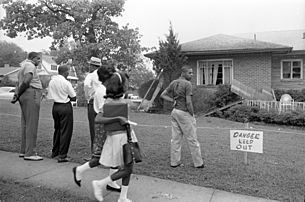Bombingham facts for kids
Quick facts for kids Bombingham |
|
|---|---|
| Part of the Civil Rights Movement | |

Locals look at the bombed home of Arthur Shores in 1963.
|
|
| Location | Birmingham, Alabama |
|
Attack type
|
Bombings, arson, shootings |
| Victims | Arthur Shores and other local African Americans |
| Perpetrators | Ku Klux Klan |
| Motive | Prevent African Americans from moving to white segregated neighborhoods. |
Bombingham is a special name given to Birmingham, Alabama. This name was used during the Civil Rights Movement. It came about because of more than 50 dynamite explosions. These blasts happened in the city between 1947 and 1965.
At first, the bombings were aimed at African Americans. These families were trying to move into neighborhoods where only white residents lived. Later, the attacks targeted anyone working to end racial segregation. Segregation meant keeping people of different races separate. One neighborhood in Birmingham had so many bombings that it became known as Dynamite Hill.
History of Bombingham
By the 1940s, many Black families wanted to buy homes. They wanted to live in areas that were mostly white in Birmingham. But the city had strict rules about where people could live based on their race. This was called segregation.
The Ku Klux Klan (KKK) was a group that supported segregation. They started a campaign of violence against Black families. These families were trying to move to the west side of Center Street. The KKK would sometimes shoot at houses. They would also throw bombs or set doors on fire. Because of these attacks, Center Street became known as Dynamite Hill.
From the late 1940s to the 1960s, over 40 bombings happened in Birmingham. Many of these crimes were never solved. The KKK specifically targeted people like Arthur Shores. He was a civil rights lawyer who lived in Birmingham. Despite the dangers, some families bravely stayed in their homes. They hoped their actions would help end segregation.
Bombings and Targets
The bombings in Birmingham targeted many different places. They were meant to scare people and stop the Civil Rights Movement. Homes of Black families were often attacked. Churches and businesses that supported civil rights were also targets.
For example, the home of Reverend Milton Curry Jr. was bombed multiple times. The home of Monroe and Mary Means Monk was also bombed. They had challenged the city's unfair housing laws. Reverend Fred Shuttlesworth, a Black minister and activist, also had his home bombed.
Civil rights lawyer Arthur Shores was a key target. His home was bombed twice in 1963. These attacks showed how much the KKK wanted to stop his work.
One of the most tragic bombings happened on September 15, 1963. This was the 16th Street Baptist Church bombing. Four young girls were killed in this terrible attack. Their names were Addie May Collins, Denise McNair, Carole Robertson, and Cynthia Wesley. This event shocked the nation and highlighted the violence in Birmingham.
Even attempts to bomb areas were part of the fear campaign. In March 1965, time bombs were found in a Black neighborhood before they could explode. In April 1965, a Black accountant's home was bombed. There were also attempts to bomb the homes of the mayor and city council members.
These bombings made Birmingham a very dangerous place. They earned the city the nickname "Bombingham." The attacks showed the extreme violence used to fight against equal rights.

